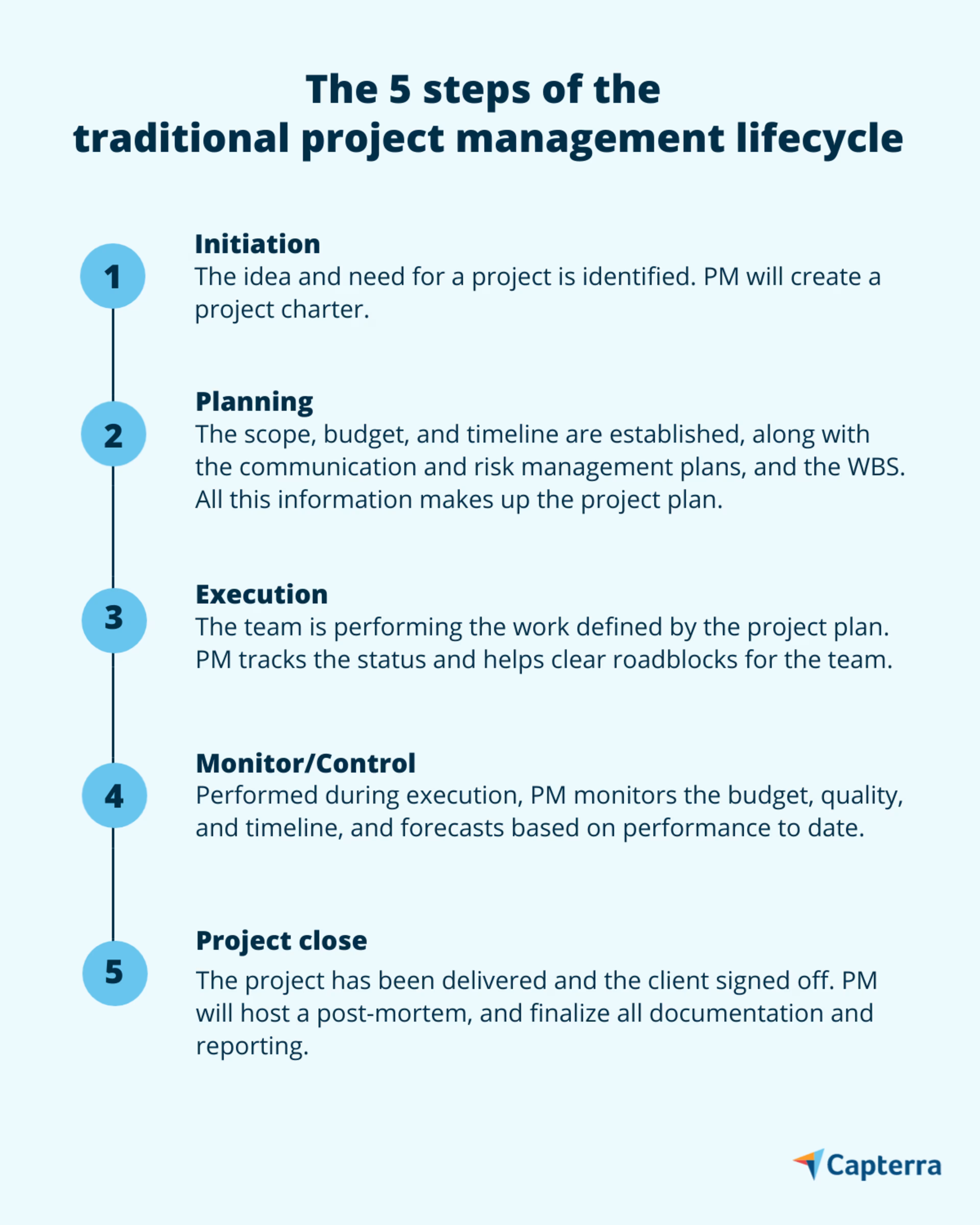Agile has been great for tech and startups, but many projects need the linear approach of traditional project management. Here’s why.

Don’t make the mistake of thinking that traditional project management is somehow subpar or even uncool now that agile is the new kid on the block. Agile has its place, especially in software development projects. But project managers need to know the classic approach to managing projects.
The rigor and structure involved in traditional project management methods are often best for complex, regulation-heavy, and/or sensitive projects, such as replacing the financial system for a publicly-traded company which will require precise and extensive documentation.
In this article, I’ll give an overview of what traditional project management is, the benefits, and explain the five phases of a project lifecycle. I’ll also touch on how to know if an agile approach would be better for your project.
This article is meant specifically for project managers who might need a tune up, but I’ll break down the what and how enough that “accidental project managers” will benefit as well.
Let’s get started with the basics.
What is a traditional project management methodology?
Traditional project management is a methodology that follows five linear phases of project design and execution. It’s also known as the waterfall method. The traditional approach is well suited for:
Complex projects with larger project teams
More stable environments where there is little use of new technologies
When specific and rigorous documentation is required
When the end product is to be delivered all at once, at the end
As you can see, projects such as the construction of buildings, planes, or really any physical deliverable are best managed with a traditional approach. Could you imagine the chaos that would ensue in a construction project where the customer wanted to see and approve of the work done every two weeks?
Benefits of traditional project management
The word “traditional” in project management doesn’t mean inflexible or old-fashioned. It means carefully designed and planned before starting work, well-defined requirements, and a clear idea of what the final deliverable will be.
Here are the benefits of using a traditional approach:
Team roles are clearly defined, allowing for efficient use of highly-specialized resources
A fully completed product is delivered at the end of the project timeline
Your client is typically involved only at the beginning and the end of the project
The linear approach helps set clear expectations with the team and stakeholders
Detailed, accurate documentation for compliance or regulatory requirements is created
The entire project will be well-prepared for stakeholder scrutiny and compliance audits
A full handoff to a new PM is fairly straightforward, in the unfortunate event that a replacement is required
Now that we’ve covered the definition and benefits of traditional project management, let’s break down this linear process I’ve mentioned a couple times now.
The five phases of the project life cycle
The linear trajectory of a project managed with a traditional approach has five steps that mostly follow each other. The exception is step four, monitoring or controlling which starts during phase three.

Let’s get into a bit more detail for each phase.
1. Initiation
This is where the idea for the project’s end deliverable starts and the upfront planning begins. During this phase, the requester is sharing their wants and needs with other stakeholders and, ideally you, the PM. In this phase, you’ll write the project charter which will outline the business problem and proposed solution, or the business case, and define the project team.
By the end of initiation, you should be able to schedule the project kickoff meeting.
2. Planning
This is the most important step and enough time needs to be scheduled to thoroughly design and plan the project. In this phase, you’ll create the complete project plan, consisting of the communication plan, risk management plan, requirements, the work breakdown structure (WBS), as well as the work cadence and project schedule.
By the end of planning, you should be able to provide the project team and senior management a Gantt chart.
Pro tip: Mark time in your project plan throughout the project to create, review, and maintain documentation. Your project not only needs to be prepared for any audits required, but the documentation also helps inform process improvements that can be made for your next project. Also, don’t underestimate the importance of good documentation even years later.
3. Execution
Now the team knows exactly what is expected of them and can begin work. As stated earlier, if the requirements aren’t clearly defined in the planning phase, some projects benefit from the hybrid approach where you can blend planning, execution, and monitor/control into an agile approach.
By the end of the project execution phase, the full project should be delivered and signed off by the client or business owner.
4. Monitor/control
This phase is where an effective PM can really shine. While I would argue that a thorough planning phase is what sets the project up for success, it is during the monitor or control phase that the team and stakeholders truly appreciate the role of the PM. During execution, the PM will create status reports, update all stakeholders regularly, update documentation, clear roadblocks for the team, and manage the quality of the work being performed.
5. Project close
This last phase involves work mostly for the PM, such as recording lessons learned, hosting a post-mortem, and checking and rechecking all documentation. Your time here will be mostly conversations with the client and team, as well as documentation.
But don’t forget to celebrate the team! You hopefully budgeted for a project close recognition of some sort, and it’s important to not overlook this step or let new work take over. Your team will appreciate not only the time together for team building, but they’ll also want to hear from the client that their work is appreciated, so invite the client or business owner, if possible.
Of course, you’re free to mix and blend techniques to best fit your project needs. Many project managers even use an agile or scrum-style approach during the execution phase, if they have clear enough requirements upfront in the project plan. This blended approach, sometimes called hybrid project management, can offer the project team and client the flexibility they want to make incremental changes and refinements while providing the structure often demanded by many senior leaders.
With that in mind, let’s take a quick look at the agile project management methodology.
When agile project management might be better
Many businesses won’t be abandoning the agile methodology anytime soon. But, our recent Project Management User survey of 422 project managers* found only 17% are using agile project management.
It’s important to know that using an agile methodology might be better when:
The project team is small
New technologies are involved
The project requirements aren't clearly defined during planning
The client or business owner wants to see incremental deliverables and make changes
There’s no one-size-fits-all approach to project management, that’s why understanding multiple techniques, methodologies, and approaches will make you better prepared to manage and deliver a successful project. And that’s likely why you’re reading this!
Recommended reading
OurProject Management Software Buyers Guide: In this guide, we'll answer the question of "what is project management software," how it benefits you, the typical functionality offered, a pricing overview, and a few things to consider when you decide to invest in a PM tool.
Capterra’sProject Management Software Shortlist: We analyzed all 1187 products in our project management software directory and took the highest-rated and most popular products and plotted them for you.
More on traditional project management techniques
What is DACI: An Explainer: A DACI matrix is your best tool for making quick and effective decisions during any project. We’ll explain why and give you 5 tips for creating one.